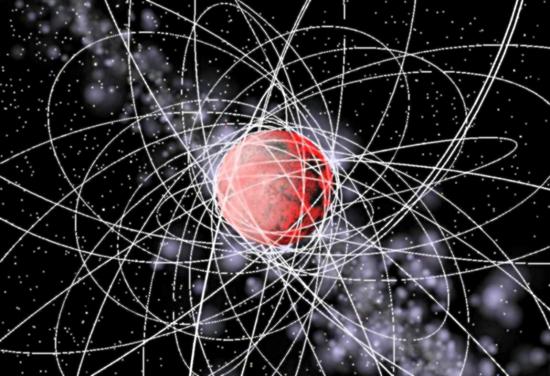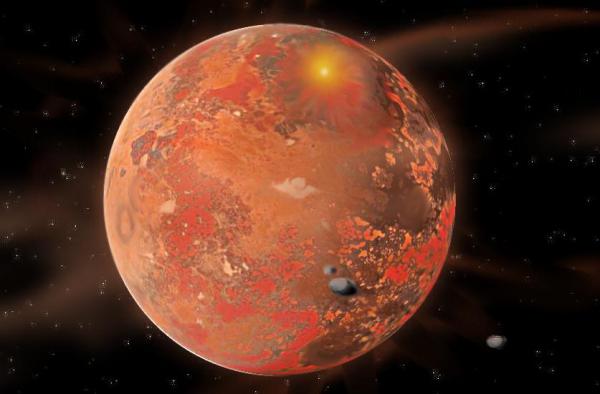BY LETTER
Artificial Planets
Technology > Application > Infrastructure
Technology > Application > Megascale Engineering
Science > Planetology
Technology > Application > Megascale Engineering
Science > Planetology
A number of very energy-costly, hi-tech or god-tech methods that allow the construction of new planets or planet-like objects to order | |
 Image from Steve Bowers | |
| During the construction of an artificial planet the object is surrounded by immense orbital loops, both to lower material to the surface of the new world, and to provide a greater surface area for cooling. | |
One of the more unusual strategies adopted in the Terragen Sphere is the construction of custom-built planets, either using typical planetary materials or as planet-shaped megastructures.
The construction of Rocky worlds
Only a limited number of worlds can be terraformed successfully, and many such worlds require constant intervention to maintain an Earth-like environment. For example; smaller worlds, which gradually lose their atmospheres and other volatiles. Such worlds can be paraterraformed, or have their volatile content constantly replenished; but such measures do not result in a world which will maintain its own environment on a geological timescale if technological intervention is discontinued. For this reason a number of very energy-costly, hi-tech or god-tech methods have been developed that allow the construction of habitable planets to order; such planets may be expected to persist for many billions of years without technological intervention.To create an Earth-like world in a system that does not have a planet of suitable mass is a great technological challenge. If there is enough rocky and metallic mass available in the system, it is possible to gather this material together to create a planet of suitable size and density, but significant amounts of energy and advanced technology are required to move such massive quantities of material around the system. Additionally the assembly of the world itself is a challenge. As material is brought together to form bodies with increasing gravity, the force of impact increases and the objects become heated. These impacts together would cause the newly assembled world to become molten, and if were left alone several million years would have to pass before the surface were cool enough to support life. Even then the world would be prone to volcanism.
In order to assemble such a world without high-energy impacts, a very large framework of elliptical dynamic orbital rings is constructed around the growing world. Incoming matter is brought to rendezvous with the outermost edges of the rings, and decelerated as it passes along the rings towards the surface. This deceleration takes the form of regenerative braking on a linear accelerator array supported by the rings, and some of the energy recovered is used to power the ring system. The process does however produce a lot of waste heat, and the orbital ring framework conducts heat away from the planet's surface and radiates it efficiently into space. Even after the planet has reached its final size, the framework remains in place for hundreds, or even thousands, of years while the surface cools down.
The energy required to re-arrange a planetary system in a reasonable time can be gathered by encasing the star in a Dyson power collection swarm, or by using various matter-to-energy conversion methods such as magmatter catalysed conversion. Small black holes of a billion tonnes (or somewhat less) can be used to generate power directly from mass, as they radiate at high temperatures. A small hole of this kind will need periodic or constant replenishment of mass or it will gradually evaporate. The so-called Hawking's Knot is a sophisticated matter-to-energy conversion system developed from the early black-hole power generators.
One of the earliest examples of large-scale artificial planet construction occurred at Gamma Leporis A+B, collectively known as Ao Lai. Both stars had extensive rocky asteroid belts with which to construct new planets; but not all systems have such resources. In other systems different methods can be used to produce worlds to order.
 Image from Steve Bowers | |
| A protoplanet in the V883 Ori system, one of many worlds in this location which have been actively managed to produce tailor-made terrestrial-scale objects, | |
Black Hole Suprashell worlds
Image from Steve Bowers | |
| Supra-black-hole worlds are constructed on a dynamically supported framework above an artificially produced, planetary mass black hole. The size of the planet is optional, as is the surface gravity; the worlds can be much smaller, or much larger, than planets with similar surface conditions. | |
In a planetary system with no suitable terrestrial planets and not enough silicate and metallic elements to build a solid world, hydrogen and helium from gas giants (or from a local star) can be used as a source of mass to form artificial planetary mass black holes, and suprashells can then be constructed above those holes to replicate a wide range of planetary environments, including Earth-like worlds.
An artificial black hole can be manufactured by compression and collision or by the controlled collapse of a suitable mass of magmatter. Hydrogen and helium (the most common elements in the universe) and other common non-rocky material can be added until the hole is slightly less massive than the desired world. For an Earth-mass planet, such a black hole is about a centimeter in radius. A dynamically supported suprashell can then be erected over the black hole using mass beam technology, and a relatively thin layer of landscaping added over the shell.
The black hole at the centre of this construct can be used to generate energy by adding mass to a controlled accretion disc which will convert mass to energy by tidal and friction effects. In operation such a hole is similar to a Deep Well Industrial zone, although the output of energy is less. Over time a certain amount of this added mass (generally 5%) will enter the event horizon and increase the total mass of the hole. This will increase the surface gravity of the planet slowly over time, unless the diameter of the dynamically supported shell is increased accordingly.
If the hole itself is rotating sufficiently fast, mass-energy can be extracted directly from the region known as the ergosphere. On the other hand black holes of planetary mass are cold objects, so the Hawking radiation cannot be used directly to generate power.
The numerous worlds of the Ecotopia Lab have been constructed in this fashion from matter extracted from the local star, and the conditions of those worlds can be adjusted as required by the Biopolity worldbuilders. Strictly speaking these worlds should be classed as planet-like objects rather than planets; but they can resemble planets very closely.
One advantage of the black hole suprashell system is that the radius of the artificial world can be much smaller, or much larger, than the equivalent rocky world. A small shell around a small hole could produce a surface gravity of one gee if required; by increasing the size of the shell the gravity can be decreased, while increasing the mass of the hole has the opposite effect. The compressed nature of the central mass offers an advantage for the black hole suprashell system, as the radius of the artificial world can be much smaller than the equivalent rocky world. Some suprashell worlds with Earthlike environments are only a few hundred kilometers across, while others are many tens of thousands of kilometres in radius. Some artificial planets have several concentric layers, and are known as ultra-tech shellworlds.
Suprashell worlds require constant maintenance, as the shell would collapse catastrophically without active control, so such worlds would not be safe if their control systems failed or were neglected.
Transmutation
A very few artificial worlds have been produced using magmatter-catalysed fusion; by fusing the lighter elements, heavier materials such as silicon, aluminium, oxygen, carbon and even iron can be produced. The process of fusion which creates such elements is highly exothermic, and locations where large scale fusion of this kind is occurring are very high energy environments.A gas giant can be mined to produce numerous Earth-masses of heavy elements using controlled fusion (for instance with a DWIZ), but in the process it will become very luminous. Starting with helium, heavier elements can be created by fusion/transmutation, but the energy produced by formation of a planet via transmutation is equivalent to several thousand years of solar luminosity.
This luminosity itself can be exploited, for instance by the construction of a Matrioshka Micronode around the giant during the transmutation process. A micronode powered by transmutation fusion can continue to operate for several thousand years until enough mass has been transformed to create a planet or other large megastructure; after which time the micronode may be dismantled. Since a micronode may contain a very large number of sentient entities, they will become displaced when the micronode ceases to operate and will generally migrate elsewhere. Some of these displaced entities may become the first inhabitants of the newly created world.
Gravity Balloons and Ederworlds
Two varieties of planet-like object can be constructed which use a massive outer skin to contain a dense atmosphere. Gravity balloons are smaller, and contain a breathable atmosphere which can support habitats of various kinds; on the other hand Ederworlds consist of a double skin of metal which encompasses a very large reservoir of hydrogen and helium extracted from gas worlds, and the habitable surface is sandwiched between the two metal layers. Ederworlds are among the largest habitable megastructures which do not rely on exotic materials.Related Articles
Appears in Topics
Development Notes
Text by Steve Bowers
Initially published on 03 September 2008.
Initially published on 03 September 2008.






